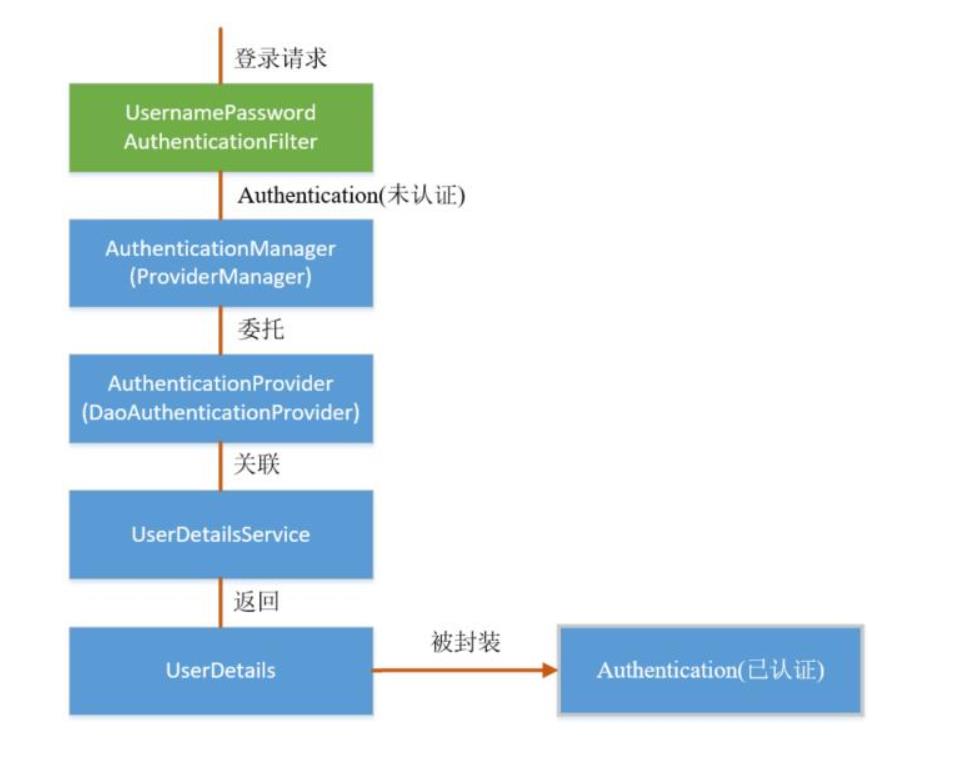SpringSecurity 微服务权限管理
Posted love the future
tags:
篇首语:本文由小常识网(cha138.com)小编为大家整理,主要介绍了SpringSecurity 微服务权限管理相关的知识,希望对你有一定的参考价值。
1.什么是微服务?

微服务的优势:
- 微服务的每个模块就相当于一个单独的项目,代码量明显减少,遇到问题也相对来说比较好解决。
- 微服务每个模块都可以使用不同的存储方式(比如Redis,mysql)数据库也是单个模块对应自己的数据库
- 微服务每个模块都可以使用不同的开发技术,开发模式增加灵活
微服务的本质

2.微服务认证与授权过程:


3.微服务权限管理数据模型
菜单资源,用户,角色还有两张用户关联多对多表的关联表
不同的用户具有多个角色,每个角色也可以分配给多个用户,并且每种角色可以访问多个不同的菜单资源。

4.主要用到的技术

环境的需要:
安装Redis和Nacos
5.项目的工程结构:

(1)工具类:
service_base中的核心工具类

spring_security中的工具类

DefaultPasswordEncoder类:
package com.lsy.security.security;
import com.lsy.utils.MD5;
import org.springframework.security.crypto.password.PasswordEncoder;
import org.springframework.stereotype.Component;
@Component
public class DefaultPasswordEncoder implements PasswordEncoder
//有参数和无参数的构造
public DefaultPasswordEncoder()
this(-1);
public DefaultPasswordEncoder(int strength)
//进行MD5加密
@Override
public String encode(CharSequence charSequence)
//charSequence需要加密的字符串
return MD5.encrypt(charSequence.toString());
//进行密码比对,看输入的密码加密后与存储的密码是否一样
@Override
public boolean matches(CharSequence charSequence, String encodedPassword)
return encodedPassword.equals(MD5.encrypt(charSequence.toString()));
Token操作工具类:TokenManager在认证授权的过程中,我们要根据用户名生成一个Token,将这个Token放到Cookie中
在TokenManager中,主要是根据用户名得到相应的Token的值,或者根据Token的值获得用门户。
使用jwt生成Token
package com.lsy.security.security;
import io.jsonwebtoken.CompressionCodecs;
import io.jsonwebtoken.Jwts;
import io.jsonwebtoken.SignatureAlgorithm;
import org.springframework.stereotype.Component;
import java.util.Date;
@Component
public class TokenManager
//token有效时长,
private long tokenEcpiration = 24*60*60*1000;
//编码秘钥,在实际的项目中是要生成的,这里进行写死。
private String tokenSignKey = "123456";
//1 使用jwt根据用户名生成token
public String createToken(String username)
//传入的是用户名
String token = Jwts.builder().setSubject(username)
.setExpiration(new Date(System.currentTimeMillis()+tokenEcpiration))
.signWith(SignatureAlgorithm.HS512, tokenSignKey).compressWith(CompressionCodecs.GZIP).compact();
//加密过程的固定写法
return token;
//2 根据token字符串得到用户信息
public String getUserInfoFromToken(String token)
String userinfo = Jwts.parser().setSigningKey(tokenSignKey).parseClaimsJws(token).getBody().getSubject();
return userinfo;
//3 删除token
public void removeToken(String token)
//可以不写删除Token的方法,因为可以在客户端上不携带Token。
退出处理类:TokenLogoutHandler
因为Token是每次发送请求时通过header传过来的,所以在退出的时候就是需要根据用户名得到Token,再根据Token在Redis中将Token进行删除
package com.lsy.security.security;
import com.lsy.utils.R;
import com.lsy.utils.ResponseUtil;
import org.springframework.data.redis.core.RedisTemplate;
import org.springframework.security.core.Authentication;
import org.springframework.security.web.authentication.logout.LogoutHandler;
import javax.servlet.http.HttpServletRequest;
import javax.servlet.http.HttpServletResponse;
//退出处理器
//LogoutHandler是security中提供的接口
public class TokenLogoutHandler implements LogoutHandler
private TokenManager tokenManager;
//需要对Redis进行操作。
private RedisTemplate redisTemplate;
//通过有参的构造传入需要的两个参数
public TokenLogoutHandler(TokenManager tokenManager,RedisTemplate redisTemplate)
this.tokenManager = tokenManager;
this.redisTemplate = redisTemplate;
@Override
public void logout(HttpServletRequest request, HttpServletResponse response, Authentication authentication)
//1 从header里面获取token
//2 token不为空,移除token,从redis删除token
//在Redis中key存的是用户名,value存放的是权限列表。
//所以要的到key,将其删除
String token = request.getHeader("token");
if(token != null)
//移除
tokenManager.removeToken(token);
//从token获取用户名
String username = tokenManager.getUserInfoFromToken(token);
//在Redis中删除
redisTemplate.delete(username);
//返回数据
ResponseUtil.out(response, R.ok());
未经授权的统一处理类:UnauthEntryPoint
package com.lsy.security.security;
import com.lsy.utils.R;
import com.lsy.utils.ResponseUtil;
import org.springframework.security.core.AuthenticationException;
import org.springframework.security.web.AuthenticationEntryPoint;
import javax.servlet.ServletException;
import javax.servlet.http.HttpServletRequest;
import javax.servlet.http.HttpServletResponse;
import java.io.IOException;
public class UnauthEntryPoint implements AuthenticationEntryPoint
@Override
public void commence(HttpServletRequest httpServletRequest, HttpServletResponse httpServletResponse, AuthenticationException e) throws IOException, ServletException
ResponseUtil.out(httpServletResponse, R.error());
编写自定义的认证与授权的过滤器:
认证过滤器:TokenLoginFilter
package com.lsy.security.filter;
import com.fasterxml.jackson.databind.ObjectMapper;
import com.lsy.security.entity.SecurityUser;
import com.lsy.security.entity.User;
import com.lsy.security.security.TokenManager;
import com.lsy.utils.R;
import com.lsy.utils.ResponseUtil;
import org.springframework.data.redis.core.RedisTemplate;
import org.springframework.security.authentication.AuthenticationManager;
import org.springframework.security.authentication.UsernamePasswordAuthenticationToken;
import org.springframework.security.core.Authentication;
import org.springframework.security.core.AuthenticationException;
import org.springframework.security.core.context.SecurityContextHolder;
import org.springframework.security.web.authentication.UsernamePasswordAuthenticationFilter;
import org.springframework.security.web.util.matcher.AntPathRequestMatcher;
import javax.servlet.FilterChain;
import javax.servlet.ServletException;
import javax.servlet.http.HttpServletRequest;
import javax.servlet.http.HttpServletResponse;
import java.io.IOException;
import java.util.ArrayList;
public class TokenLoginFilter extends UsernamePasswordAuthenticationFilter
private TokenManager tokenManager;
private RedisTemplate redisTemplate;
private AuthenticationManager authenticationManager;
//构造方法
public TokenLoginFilter(AuthenticationManager authenticationManager, TokenManager tokenManager, RedisTemplate redisTemplate)
this.authenticationManager = authenticationManager;
this.tokenManager = tokenManager;
this.redisTemplate = redisTemplate;
this.setPostOnly(false);
this.setRequiresAuthenticationRequestMatcher(new AntPathRequestMatcher("/admin/acl/login","POST"));
//1 获取表单提交用户名和密码
@Override
public Authentication attemptAuthentication(HttpServletRequest request, HttpServletResponse response)
throws AuthenticationException
//获取表单提交数据
try
User user = new ObjectMapper().readValue(request.getInputStream(), User.class);
//用户名密码和权限列表
return authenticationManager.authenticate(new UsernamePasswordAuthenticationToken(user.getUsername(),user.getPassword(),
new ArrayList<>()));
catch (IOException e)
e.printStackTrace();
throw new RuntimeException();
//2 认证成功调用的方法
@Override
protected void successfulAuthentication(HttpServletRequest request,
HttpServletResponse response, FilterChain chain, Authentication authResult)
throws IOException, ServletException
//认证成功,得到认证成功之后用户信息,会存放在Authentication authResult中,通过getPrincipal可以获得对应对象。
SecurityUser user = (SecurityUser)authResult.getPrincipal();
//根据用户名生成token
String token = tokenManager.createToken(user.getCurrentUserInfo().getUsername());
//把用户名称和用户权限列表放到redis
redisTemplate.opsForValue().set(user.getCurrentUserInfo().getUsername(),user.getPermissionValueList());
//返回token
ResponseUtil.out(response, R.ok().data("token",token));
//3 认证失败调用的方法
protected void unsuccessfulAuthentication(HttpServletRequest request, HttpServletResponse response, AuthenticationException failed)
throws IOException, ServletException
ResponseUtil.out(response, R.error());
授权过滤器:TokenAuthFilter
package com.lsy.security.filter;
import com.lsy.security.security.TokenManager;
import org.springframework.data.redis.core.RedisTemplate;
import org.springframework.security.authentication.AuthenticationManager;
import org.springframework.security.authentication.UsernamePasswordAuthenticationToken;
import org.springframework.security.core.GrantedAuthority;
import org.springframework.security.core.authority.SimpleGrantedAuthority;
import org.springframework.security.core.context.SecurityContextHolder;
import org.springframework.security.web.authentication.www.BasicAuthenticationFilter;
import javax.servlet.FilterChain;
import javax.servlet.ServletException;
import javax.servlet.http.HttpServletRequest;
import javax.servlet.http.HttpServletResponse;
import java.io.IOException;
import java.util.ArrayList;
import java.util.Collection;
import java.util.List;
public class TokenAuthFilter extends BasicAuthenticationFilter
private TokenManager tokenManager;
private RedisTemplate redisTemplate;
public TokenAuthFilter(AuthenticationManager authenticationManager,TokenManager tokenManager,RedisTemplate redisTemplate)
super(authenticationManager);
this.tokenManager = tokenManager;
this.redisTemplate = redisTemplate;
@Override
protected void doFilterInternal(HttpServletRequest request, HttpServletResponse response, FilterChain chain) throws IOException, ServletException
//获取当前认证成功用户权限信息
UsernamePasswordAuthenticationToken authRequest = getAuthentication(request);
//判断如果有权限信息,放到权限上下文中
if(authRequest != null)
SecurityContextHolder.getContext().setAuthentication(authRequest);
chain.doFilter(request,response);
private UsernamePasswordAuthenticationToken getAuthentication(HttpServletRequest request)
//从header获取token
String token = request.getHeader("token");
if(token != null)
//从token获取用户名
String username = tokenManager.getUserInfoFromToken(token);
//从redis获取对应权限列表
List<String> permissionValueList = (List<String>)redisTemplate.opsForValue().get(username);
Collection<GrantedAuthority> authority = new ArrayList<>();
for(String permissionValue : permissionValueList)
SimpleGrantedAuthority auth = new SimpleGrantedAuthority(permissionValue);
authority.add(auth);
return new UsernamePasswordAuthenticationToken(username,token,authority);
return null;
security的核心配置类 TokenWebSecurityConfig
package com.lsy.security.config;
import com.lsy.security.filter.TokenAuthFilter;
import com.lsy.security.filter.TokenLoginFilter;
import com.lsy.security.security.DefaultPasswordEncoder;
import com.lsy.security.security.TokenLogoutHandler;
import com.lsy.security.security.TokenManager;
import com.lsy.security.security.UnauthEntryPoint;
import org.springframework.beans.factory.annotation.Autowired;
import org.springframework.context.annotation.Configuration;
import org.springframework.data.redis.core.RedisTemplate;
import org.springframework.security.config.annotation.authentication.builders.AuthenticationManagerBuilder;
import org.springframework.security.config.annotation.method.configuration.EnableGlobalMethodSecurity;
import org.springframework.security.config.annotation.web.builders.HttpSecurity;
import org.springframework.security.config.annotation.web.builders.WebSecurity;
import org.springframework.security.config.annotation.web.configuration.EnableWebSecurity;
import org.springframework.security.config.annotation.web.configuration.WebSecurityConfigurerAdapter;
import org.springframework.security.core.userdetails.UserDetailsService;
@Configuration
@EnableWebSecurity
@EnableGlobalMethodSecurity(prePostEnabled = true)
public class TokenWebSecurityConfig extends WebSecurityConfigurerAdapter
private TokenManager tokenManager;
private RedisTemplate redisTemplate;
private DefaultPasswordEncoder defaultPasswordEncoder;
private UserDetailsService userDetailsService;
@Autowired
public TokenWebSecurityConfig(UserDetailsService userDetailsService, DefaultPasswordEncoder defaultPasswordEncoder,
TokenManager tokenManager, RedisTemplate redisTemplate)
this.userDetailsService = userDetailsService;
this.defaultPasswordEncoder = defaultPasswordEncoder;
this.tokenManager = tokenManager;
this.redisTemplate = redisTemplate;
/**
* 配置设置
* @param http
* @throws Exception
*/
//设置退出的地址和token,redis操作地址
@Override
protected void configure(HttpSecurity http) throws Exception
http.exceptionHandling()
.authenticationEntryPoint(new UnauthEntryPoint())//没有权限访问
.and().csrf().disable()
.authorizeRequests()
.anyRequest().authenticated()
.and().logout().logoutUrl("/admin/acl/index/logout")//退出路径
.addLogoutHandler(new TokenLogoutHandler(tokenManager,redisTemplate)).and()
.addFilter(new TokenLoginFilter(authenticationManager(), tokenManager, redisTemplate))
.addFilter(new TokenAuthFilter(authenticationManager(), tokenManager, redisTemplate)).httpBasic();
//调用userDetailsService和密码处理
@Override
public void configure(AuthenticationManagerBuilder auth) throws Exception
auth.userDetailsService(userDetailsService).passwordEncoder(defaultPasswordEncoder);
//不进行认证的路径,可以直接访问
@Override
public void configure(WebSecurity web) throws Exception
web.ignoring().antMatchers("/api/**");
网关的作用:
对外暴露出统一的端口,然后用户直接访问网关,通过网关转发到具体的模块中。
使用的是SpringCloud中的一个组件gateway
api-gateway模块中的配置类:
package com.lsy.gateway.config;
import org.springframework.context.annotation.Bean;
import org.springframework.context.annotation.Configuration;
import org.springframework.web.cors.CorsConfiguration;
import org.springframework.web.cors.reactive.CorsWebFilter;
import org.springframework.web.cors.reactive.UrlBasedCorsConfigurationSource;
import org.springframework.web.util.pattern.PathPatternParser;
//解决的是跨域问题。
@Configuration
public class CorsConfig
//解决跨域
@Bean
public CorsWebFilter corsWebFilter()
CorsConfiguration config = new CorsConfiguration();
config.addAllowedMethod("*");
config.addAllowedOrigin("*");
config.addAllowedHeader("*");
UrlBasedCorsConfigurationSource source = new UrlBasedCorsConfigurationSource(new PathPatternParser());
source.registerCorsConfiguration("/**",config);
return new CorsWebFilter(source);
接下来就是编写相应的UserDetailsService
package com.lsy.service.impl;
import com.lsy.security.entity.SecurityUser;
import com.lsy.entity.User;
import com.lsy.service.PermissionService;
import com.lsy.service.UserService;
import org.springframework.beans.BeanUtils;
import org.springframework.beans.factory.annotation.Autowired;
import org.springframework.security.core.userdetails.UserDetails;
import org.springframework.security.core.userdetails.UserDetailsService;
import org.springframework.security.core.userdetails.UsernameNotFoundException;
import org.springframework.stereotype.Service;
import java.util.List;
@Service("userDetailsService")
public class UserDetailsServiceImpl implements UserDetailsService
@Autowired
private UserService userService;
@Autowired
private PermissionService permissionService;
@Override
public UserDetails loadUserByUsername(String username) throws UsernameNotFoundException
//根据用户名查询数据
User user = userService.selectByUsername(username);
//判断
if(user == null)
throw new UsernameNotFoundException("用户不存在");
com.lsy.security.entity.User curUser = new com.lsy.security.entity.User();
BeanUtils.copyProperties(user,curUser);
//根据用户查询用户权限列表
List<String> permissionValueList = permissionService.selectPermissionValueByUserId(user.getId());
SecurityUser securityUser = new SecurityUser();
securityUser.setCurrentUserInfo(curUser);
securityUser.setPermissionValueList(permissionValueList);
return securityUser;
其他相关的代码见代码连接:
后端代码地址:
https://github.com/lsy-sunny/spring-security.git
前端代码地址:
https://github.com/lsy-sunny/springsecurity-admin
可以通过查看Redis得到存储在Redis中的角色权限

在nocos中可以看到相应的服务名:
访问:
http://localhost:8848/nacos/index.html
默认用户名和密码是:nacos,nacos

启动前端项目就可以进行访问,没有授权的路径,是无法访问的。

登录授权的过程:


以上是关于SpringSecurity 微服务权限管理的主要内容,如果未能解决你的问题,请参考以下文章